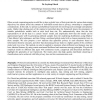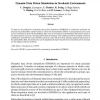100
click to vote
ML
2006
ACM
15 years 9 days ago
2006
ACM
We investigate explicit segment duration models in addressing the problem of fragmentation in musical audio segmentation. The resulting probabilistic models are optimised using Mar...
76
Voted
JSC
2006
15 years 9 days ago
2006
To calibrate Fourier analysis of S5 ranking data by Markov chain Monte Carlo techniques, a set of moves (Markov basis) is needed. We calculate this basis, and use it to provide a ...
102
click to vote
CVIU
2007
15 years 10 days ago
2007
A Bayesian framework is proposed for stereo vision where solutions to both the model parameters and the disparity map are posed in terms of predictions of latent variables, given ...
76
Voted
CSDA
2007
15 years 10 days ago
2007
Many probabilistic models are only defined up to a normalization constant. This makes maximum likelihood estimation of the model parameters very difficult. Typically, one then h...
ISI
2008
Springer
15 years 10 days ago
2008
Springer
Often several cooperating parties would like to have a global view of their joint data for various data mining objectives, but cannot reveal the contents of individual records due...
110
click to vote
BMCBI
2007
15 years 11 days ago
2007
Background: Yu et al. (BMC Bioinformatics 2007,8: 145+) have recently compared the performance of several methods for the detection of genomic amplification and deletion breakpoin...
103
click to vote
CSDA
2006
15 years 11 days ago
2006
Generalized additive models (GAM) for modelling nonlinear effects of continuous covariates are now well established tools for the applied statistician. In this paper we develop Ba...
115
Voted
COMPUTING
2006
15 years 12 days ago
2006
To improve the predictions in dynamic data driven simulations (DDDAS) for subsurface problems, we propose the permeability update based on observed measurements. Based on measurem...
BMCBI
2006
15 years 12 days ago
2006
Background: The aim of protein design is to predict amino-acid sequences compatible with a given target structure. Traditionally envisioned as a purely thermodynamic question, thi...
CSDA
2008
15 years 13 days ago
2008
A model-based clustering method is proposed for clustering individuals on the basis of measurements taken over time. Data variability is taken into account through non-linear hier...


